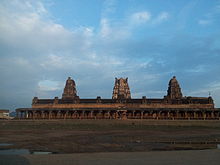Kodandarama Temple, Vontimitta
| Kodanda Rama Swamy Temple కోదండరామస్వామి ఆలయం | |
|---|---|
 View of the Kodandarama Swamy Temple in Vontimitta | |
| Religion | |
| Affiliation | Hinduism |
| District | Kadapa |
| Deity | Sita
Andhra |
| Country | India |
| Geographic coordinates | 14°23′00″N 79°02′00″E / 14.3833°N 79.0333°E |
| Architecture | |
| Type | Dravidian architecture |
| Creator | Chola and Vijayanagara Kings |
| Completed | 16th century |
| Specifications | |
| Monument(s) | 3 |
| Elevation | 151 m (495 ft) |
Kodandarama Temple is a
Legend
According to the local legend, the temple was built by Vontudu and Mittudu they was nishada(boya) vamsha, who were robbers-turned-devotees of Rama. After building the temple, they are said to have turned into stone.[2]
History
The temple was built during the reign of
Features


The temple, the largest in the region[3] is built in Vijayanagara style of architecture, in the "Sandhara" order[5] within a rectangular yard enclosed by walls. The temple, located 16 kilometres (9.9 mi) from Siddhout via Bakarapeta, is architecturally elegant and impressive. It has three ornate Gopurams (towers) of which the central tower, which faces east, is the entrance gateway to the temple; the other two towers face north and south. This central tower is built in five tiers, and a number of steps are provided to access the approach gate of the tower.[3][5]
The
The sanctum sanctorum or garbhagriha is approached from the mandapa through an antaraalayam or inner chamber, which is adorned with sculptures.[citation needed] In the garbhagriha, the central icon of Rama along with his consort Sita and Lakshmana are carved as a composite image, out of a single rock. It is also inferred that the garbhagriha is itself carved out of a single block. The Hanuman, Rama's devotee, who is generally shown with the trio is missing here. However, there is a separate temple for Hanuman here. There is also an image of Ganesha in a dancing posture in the mandapam.[4]
The state government has decided to take over the upkeep of this temple, which is presently with the Archaeological Survey of India (ASI). This temple is notified as an Ancient Monument (N-AP-50) by ASI.[9] The two sacred water tanks – Rama theertham and Lakshmana theertham – are located in the precincts of the temple.[2]
Administration
The Administration of the Temple is entrusted to the Tirumala Tirupati Devasthanams (TTD) by the Government of Andhra Pradesh. The TTD board had passed a resolution on 29 July 2015 to get the temple under its administrative control.[10]
Festival
See also
- Bhadrachalam Temple
- List of temples under Tirumala Tirupati Devasthanams
- List of Monuments of National Importance in Andhra Pradesh
References
- ^ "Centrally Protected Monuments". Archeological Survey of India. Archived from the original on 26 June 2017. Retrieved 27 May 2017.
- ^ a b c "Sri Kodandarama Swamy Temple at Vontimitta". Indian Express. Archived from the original on 11 May 2016. Retrieved 8 September 2014.
- ^ a b c d Michell 2013, p. 333.
- ^ a b "Sri Kodanda Rama Swamy Temple, Vontimitta, Kadapa". Government of Andhra Pradesh Tourism. Archived from the original on 20 February 2015. Retrieved 19 February 2015.
- ^ a b Kamalakar 2004, p. 114.
- ^ Kamalakar 2004, p. 120.
- ^ Gurumurthi 1990, p. 18.
- ^ Gurumurthi 1990, p. 20.
- ^ a b "Vontimitta temple to host Ramnavami fete". The Times of India. 21 February 2015.
- ^ "Ontimitta temple brought under TTD fold". The Hindu. 29 July 2015.
Bibliography
- Gurumurthi, Aenuganti (1990). Sculpture and Iconography: Cuddapah District Temples. New Era Publications. OCLC 23760017.
- Kamalakar, G. (1 January 2004). Temples of Andhradesa: Art, Architecture & Iconography : with Special Reference to Renandu (Cuddapah) Region. Sharada Publishing House. ISBN 978-81-88934-18-8.
- Michell, George (1 May 2013). Southern India: A Guide to Monuments Sites & Museums. Roli Books Private Limited. ISBN 978-81-7436-903-1.








